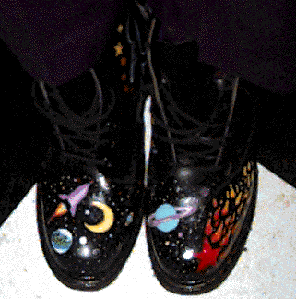
I painted the mural-like spacescape of rockets, planets, magical vines, hoodoo symbols, and nucleic acids on a pair of Doc Martens in December, 1994, after quitting the last job I'll ever have. I wasn't quite sure why I was doing it. Over the years that have passed since then, it has become clear that I was preparing my travelling shoes. I've been around the world in them a dozen times. Manhattan slush failed to peel the paint. They still look pretty good, although covered by a web of fine cracks.
It started when my Judy pointed out a pair of shoes showcased in a local publication. Someone had painted Van Gogh's "Starry Night" on a pair of shoes. The store showcased in the publication didn't actually have the shoes, but did direct me to the artist, who sold me a pair. I wore them on my travels. They led me into many adventures, all of them pleasant. However, I tired of saying: "No, it was painted by a young woman named Jessica who lives in San Francisco" when people inevitably asked me: "Did you paint those yourself?" So I set out to paint a pair of shoes. I painted flourescent orange shoes with green vines all over them and they were very cool until the next morning when the paint all flaked off. It took a year of trying, but I persuaded Jessica to teach me her shoe painting technique. Jessica is the mother-goddess of the paint your shoe anarchult. Thank you, Jessica.
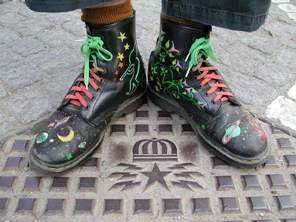
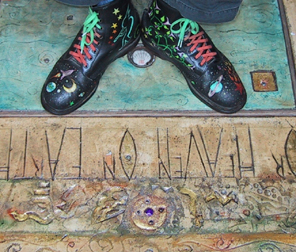
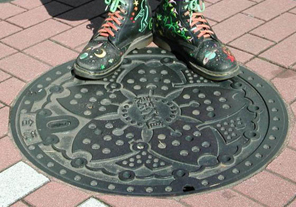
How To Paint Little Murals on Your Shoes
I chose Doc Martens for sturdiness. If you are going to paint leather shoes, choose something sturdy. Canvas shoes can be painted, and don't require a white undercoat the way leather does. The more the shoe bends, the softer the leather or canvas, the more cracks will appear in the dried paint. If you are going to use leather, start with black. I stripped as much of the wax and dye off the surface of the leather with acetone and old washcloths. CAUTION: Acetone is inflammable, volatile, poisonous, bad for the environment, and not to be spilled on your cat, your lawn or your skin. Use gloves, do it outside, and avoid all sources of flame if you are going to use acetone. It isn't absolutely necessary. The next step is more important: Take a long time to sand the surface of the shoe with fine but not superfine grit sandpaper. You need to raise a "tooth" on the leather to absorb the paint. Listen to the right music and sanding your shoes can be a groove. Remember "Karate Kid II?" "Wax on, wax off." Repetition-mind.
After you have sanded and sanded and sanded, you can draw your design on the shoe with a pencil. First, put the shoes on and flex them. Notice where the shoes naturally wrinkle and bend. Those are places where paint will crack, so plan your design around them. The area between the toe and the tongue, the sides, and the back of the shoe all have good areas for painting figures. When you finish your drawing, dilute high-quality WHITE acrylic paint so it is not too thin. Paint should not naturally drip off the brush -- you should have to shake it gently to dislodge the paint. Thick, but not too thick. Use gloves with acrylic or wash your hands within a few minutes of getting paint on them. Acrylic dries quickly. Use a drop cloth and scrub with water immediately any place you spill paint.
Then, with the tiniest brush you can find, make tiny white dots everywhere you plan to put color on the shoe. But DON'T fill in the spaces on your design. You want large black spaces between the dots. Think "pointillism." Let the first coat of white drops dry in the sun or a warm place for half an hour. Then put tiny white dots between the first coat of white dots, partially but not totally filling in the design. Then let it dry for half an hour and do it again. Four or five passes should fill in your painting surface. Let it dry for a couple hours. When you add color, do it the same way, in tiny dots of fairly thick but not globby paint. Paint the color on the white you have laid down. Let it dry for 24 hours. Drying in the sun is good but not absolutely required. The next step must take place outdoors. Put down a dropcloth and use a mask or cloth over your nose and mouth. Apply a very thin coat of a clear acrylic spray to the entire surface of the shoe. Let it dry at least an hour then add another very thin coat. Let the shoes dry for at least 24 hours, then add two more very light coats of clear acrylic spray, an hour apart.
I painted the shoes pictured here this way, and another pair for my daughter, and another pair for my friend David to get married in. Then I decided it was way too much hassle. If you have a specific design in mind and want to paint a mural, it can be done, but it is a long, painstaking process, possibly involving toxic chemicals.
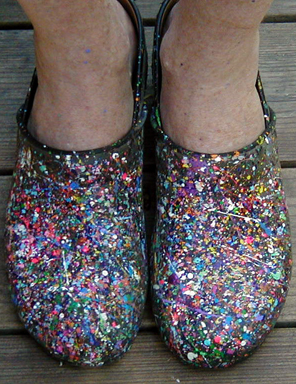
How To Paint If You Can't Draw
First of all, the point of the exercise is to demonstrate that we are all artists. Don't worry if you can't draw a horse that looks like a horse. A few years ago, I started buying good quality clogs for around seventy five dollars, splattering them with acrylics, then wore them night and day, summer and winter, for two to three years before I had to replace them and paint a new pair. I buy black leather clogs, don't treat the leather at all, put down a dropcloth (well, now I do -- when I used this technique to paint our costumes for the Mind Shaft Society expedition to Burning Man 2000, I permanently colored the asphalt in my driveway), mix up acrylics in cheap paper cups with cheap fat brushes, crank up the tunes, dance around and holler and use my whole body, flicking my wrist spasmodically yet aesthetically, and splatter the shoes. There are many ways of splattering -- big ropy spills like Jackson Pollock, or dots on dots on dots of various sizes and colors, or both techniques. I've had splatter-painting parties where a dozen people splattered at once. You need a large space for this, or many showers or high pressure hose immediately available! Another easy way to paint is to cut small stencils -- stars, moons, other easily recognizable icons -- out of cardboard. Or dab away freestyle. Just remember to use small dabs and small brushes and let the dabs dry before they run together. When you use normal brushstrokes, the paint dries in a sheet and flakes off in a sheet.
You will get an immediate friendly response from people when you wear your shoes in public. People will ask: "Are you an artist?" to which I encourage you to say: "Yes! And we can ALL be artists!" then evangelize your admirers to paint their own shoes. Be sure to add that it signifies nothing more than your willingness to paint your shoes. Isn't it a little weird that there are billions of shoes in the world and 99.99% of them are black or brown?
It is possible that cool hunters will track down someone in the right demographic, capture their painted clogs, and some global brand will commodify painted shoes and sell them worldwide. This is fine! It means more people will be wearing large numbers of random colors! At that point, we can move on to painting shirts, pants, and hats. If the commodification engine wants to chew it all up, terrific! The world will be a more colorful place, and we can think of new ways to make art out of our lives.